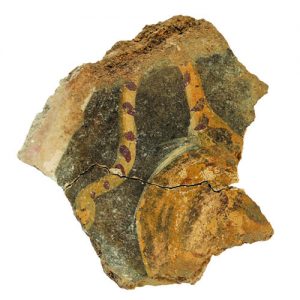
 An archaeological team from the Hebrew University has discovered hundreds of fragments belonging to frescoes from the Roman period in the Zippori National Park. The fragments, which contain figurative images, floral patterns and geometric motifs, shed light on Zippori (Sepphoris), which was an important urban center for the Jews of the Galilee during the Roman and Byzantine periods.
An archaeological team from the Hebrew University has discovered hundreds of fragments belonging to frescoes from the Roman period in the Zippori National Park. The fragments, which contain figurative images, floral patterns and geometric motifs, shed light on Zippori (Sepphoris), which was an important urban center for the Jews of the Galilee during the Roman and Byzantine periods.
The frescoes decorated a monumental public building that was erected in the early second century AD north of the decumanus, a colonnaded street that cut across the city from east to west and continued to the foot of the Acropolis. In the center of the building was a stone-paved courtyard and side portico decorated with stucco. West and north of the courtyard, several underground vaults were discovered. Some of these were used as water cisterns and were of high quality construction. The monumental building was built on the slope and the vaults were designed to allow the construction of the superstructure located on the level of the decumanus.
The patterns on the plaster fragments are varied and are decorated in many colors. Among them are geometric patterns (guilloche) and brightly colored wall panels. Other fragments contain floral motifs (light shaded paintings on red backgrounds or various colors on a white background). Particularly important are the pieces which depict figures—the head of a lion, a horned animal (perhaps a bull), a bird, a tiger’s hindquarters and more—usually on a black background. At least one fragment contains a depiction of a man bearing a club.
The population of Zippori prior to the Great Revolt against the Romans was not very large, and archaeological finds dating to this period are particularly notable for the absence of figurative images—both humans and animals. The construction of the Roman city of Zippori after the Great Revolt, in the late first century and the second century AD, is indicative of a change in the attitude of Galilean Jews toward Rome and its culture. The city gained the status of a polis thanks to its loyalty to Rome during the Great Revolt, and constructed monumental public buildings, as befit a polis, that stood out in the urban landscape.
While the earliest mosaics discovered at the site date to around 200 AD, the ancient frescoes precede them by about a hundred years and are thus of great importance.
Source: Excerpts of an article by Edgar Asher, Ashernet
All logos and trademarks in this site are property of their respective owner. All other materials are property of Bridges for Peace. Copyright © 2025.
Website Site Design by J-Town Internet Services Ltd. - Based in Jerusalem and Serving the World.